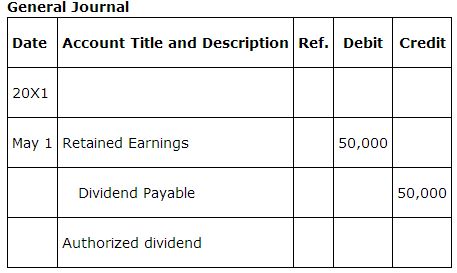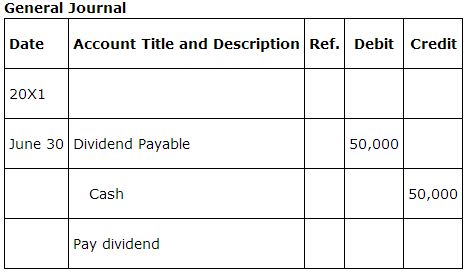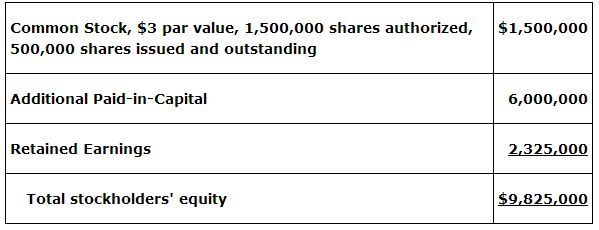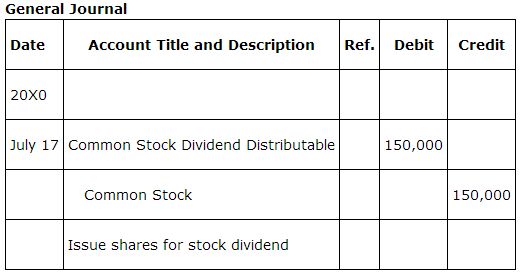Date of record.
Date of payment or distribution.
The date of declaration is the date the Board of Directors formally authorizes for the payment of a cash dividend or issuance of shares of stock. This date establishes the liability of the company. On this date, the value of the dividend to be paid or distributed is deducted from retained earnings. The date of record does not require a formal accounting entry. It establishes who will receive the dividend. The date of payment or distribution is when the dividend is given to the stockholders of record.
If a company has both preferred and common stockholders, the preferred stockholders receive a preference if any dividend is declared. Having the preference does not guarantee preferred stockholders a dividend, it just puts them first in line if a dividend is paid. Preferred stock usually specifies a dividend percentage or a flat dollar amount. For example, preferred stock with a $100 par value has a 5% or $5 dividend rate. Five percent is the $5 dividend divided by the $100 par value. This means all preferred stockholders will receive a $5 per share dividend before any dividend is paid to common stockholders. Some shares of preferred stock have special dividend features such as cumulative dividend or participating dividend.
A cumulative dividend means if dividends are declared, preferred stockholders will receive their current‐year dividend plus any dividends not paid in prior years before the common stockholders receive a dividend. Owning a share of preferred stock that includes a cumulative dividend still does not guarantee the preferred stockholder a dividend because the company is not liable to pay dividends until they are declared. Having cumulative preferred stock simply reinforces the preference preferred stockholders receive when a dividend is declared. If a company has issued cumulative preferred stock and does not declare a dividend, the company has dividends in arrears. Although not a liability, the amount of any dividends in arrears must be disclosed in the financial statements.
The participating dividend feature provides the opportunity for the preferred stockholders to receive dividends above the stated rate. It occurs only after the common stockholders have received the same rate of return on their shares as the preferred stockholders. For example, say the preferred dividend rate is 5% and the preferred stock has a participating feature. This means that the preferred stockholders will receive a larger dividend if the authorized dividend exceeds the total of the 5% dividend for the preferred stockholder and a 5% dividend to the common stockholders.
On May 1, the Board of Directors of Triple Play authorized payment of a $50,000 cash dividend on June 30 to the stockholders of record on May 25. On May 1, the date of declaration, the value of the dividend to be paid is deducted from (debited to) retained earnings and set up as a liability in a separate dividends payable account.

It should be noted that some companies use separate accounts called “Dividends, Common Stock” and “Dividends, Preferred Stock” rather than retained earnings to record dividends declared. If these accounts are used, a closing entry is made at the end of the period to decrease (debit) retained earnings and decrease (credit) “Dividends, Common Stock” and “Dividends, Preferred Stock” to zero out the balances in the dividend accounts and update the retained earnings balance.
On the date of payment when the cash is sent out to the stockholders, the dividends payable account is decreased (debited) and the cash account is decreased (credited).

Once declared and paid, a cash dividend decreases total stockholders' equity and decreases total assets. Dividends are not reported on the income statement. They would be found in a statement of retained earnings or statement of stockholders' equity once declared and in a statement of cash flows when paid.
Stock dividends
Stock dividends are used when a company needs to maintain its cash in the business but wants to provide a dividend to its stockholders. The size of a stock dividend determines how it is valued. A small size dividend (less than 20–25% of outstanding shares) is usually valued at the market value of the stock. A large size dividend (more than 20–25% of outstanding shares) is usually valued at par or stated value.
Assume the Board of Directors of Grandma's Girls authorizes a 10% stock dividend on May 20th, distributable on July 17th to stockholders of record on June 9th when the stock is selling for $20 per share. Before the dividend, the company's balance sheet had the following stockholders' equity section:
Common Stock, $3 par value, 1,500,000 shares authorized, 500,000 shares issued and outstanding

The $1,000,000 value of the dividend is determined by multiplying the 50,000 shares to be issued (10% × 500,000 outstanding shares) by $20 (market value of stock). The entry to record the declaration of the dividend decreases (debits) retained earnings for the $1,000,000 market value of the shares to be issued, increases (credits) common stock dividend distributable for the $150,000 par value of the shares to be issued($3 × 50,000), and increases (credits) additional paid‐in‐capital for the difference between the par (or stated value) and the market value of $850,000 ($50,000 × ($20 – $3)).

On July 17th when the shares of stock are distributed to the stockholders, an entry is made to decrease (debit) common stock dividend distributable and increase (credit) common stock for $150,000, the par (or stated value).

The net effect of the entries recorded when a stock dividend is declared and distributed is a change in the components of stockholders' equity but not in total stockholders' equity or assets.
|
|
|
|
|
|
|
|
|
|
|
|
|
|
|